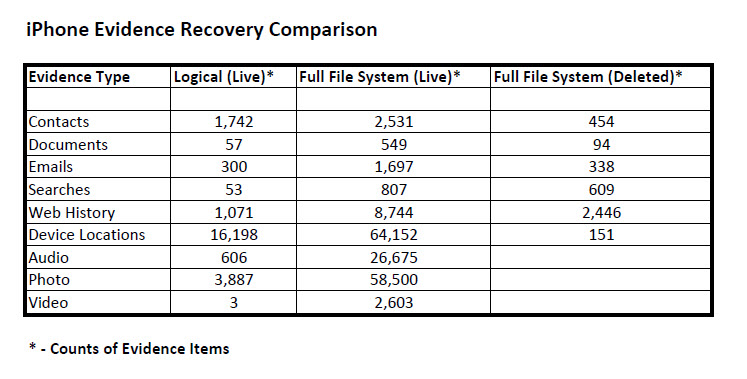
Steve Jobs introduced Apple’s new iPhone in June 2007 and it immediately became a successful product. Its popularity in America has grown, insanely some would say, to become the smartphone market share leader at 47% as of Q2 2020. Apple’s advances in privacy and personal safety using encryption, multiple passwords, two-factor authentication, and many other security best practices have attracted millions of users.
From personal polling at digital evidence CLEs I have presented over the years here in Minnesota I have learned that the vast majority of lawyers in this state are iPhone users. So are many of their clients and the public. Thus, the iPhone has become an unparalleled source of mobile evidence from not only iPhone handsets but also the connected, online iCloud account to which most users opt-in. America’s most popular smartphone has become a materially important source of the best evidence for civil and criminal litigation.
What is the History of iPhone Forensics?
The history of the iPhone now spans fifteen years. But, the golden era of iPhone forensics history began in 2007 and lasted for three years until Apple introduced the iPhone 4 in June of 2010. It came to a screeching halt in the fourth year with the release of the iPhone 4S in October 2011. In those early days all mobile evidence, live and active, deleted, and discarded evidence in unallocated storage was ready and waiting for the examiner’s recovery using straightforward tools.
The iPhone 4 introduction eliminated email evidence recovery from iPhones. And then the iPhone 4S release with its hardware encryption eliminated physical extractions in their entirety. Gone were many previously available types of evidence. And gone were the voluminous quantities of deleted evidence. Last, gone was discarded evidence in unallocated storage including deleted, forgotten photos and videos and so much more.
The year 2011 brought mobile device forensic examiners the iPhone logical extraction to rely upon exclusively for evidence recovery. And the effectiveness of iPhone forensics to produce probative evidence has been declining ever since for almost a decade.
Logical iPhone Extractions Give Way to Probative Full File Systems
What is a logical extraction? It is a technique for extracting files and folders with none of the deleted data from a mobile device. However, some describe logical extraction narrowly as the ability to gather a particular data type, such as contacts, call logs, text messages, calendars, photographs, videos, and some mobile app evidence. Forensic examiners use a software tool to make a copy of the files. For example, they use Apple’s iTunes backup to make a logical extraction of an iPhone or iPad.
Reliance on only the logical extraction method introduces limitations to evidence extraction and probativeness. Apple’s iTunes has controlled access to iPhone handsets for almost a decade to the chagrin of mobile device forensic examiners around the world. Besides skimming only the surface of mobile evidence on iPhone handsets, iTunes made extraction even more difficult by honoring three passcodes that hide evidence on iPhones.
A Major Transformational Advance in iPhone Forensics
But that medieval period has come to an end. A major, transformational advance introduced earlier this year in 2020 marks the return of iPhone forensics for the foreseeable future. It doesn’t feature a physical extraction like the golden era of 2007 to 2010 but is the next best thing. It’s called a full file system extraction by examiners. It recovers the entire iOS file system for extraordinary iPhone evidence collection and production for admissibility in legal matters. It recovers vastly greater quantities of live and deleted evidence including qualitatively new forms of highly probative evidence compared to what’s been available the past decade.
How does it work? Full file system extractions exploit a weakness in Apple’s iPhone operating system in a forensically sound, generally accepted way without risking changes to the file system. Recovery of the full file system without changing it exposes all the iPhone evidence to analysis, both live and deleted, including messages, chats, contacts, voice messages, device locations, health and activity tracking, and many other mobile apps. It is supported by the best, most respected tools in the mobile device forensic industry to recover, analyze, and produce admissible evidence.
Return to Probativeness
While logical iPhone extractions over the past decade have recovered a reasonable amount of live (non-deleted) evidence items, full file system extractions perform substantially better. They produce superior quantities of live and deleted evidence and are meaningfully more probative. In general, lawyers can expect about three to five times more gigabytes of data capacity from an iPhone full file system extraction compared to a logical extraction. Experiments performed in my lab on two test iPhones and a test iPad show full recoveries of all gigabytes of storage in use on the device. Storage “in use” is the total storage capacity on the device minus the storage available for new evidence.
But lawyers care more about actual evidence and not the data capacity to store it. Contacts, emails, documents, and text messages mean more than gigabytes of storage. Please see the table below which shows a comparison of iPhone evidence types recovered during the past decade from logical extractions as contrasted with the breakthrough quantities of live and deleted evidence types recovered today from full file system extractions.

Forensic Recovery of New Types of iPhone Evidence
What’s more, full file system extractions are unearthing qualitatively new types of iPhone evidence examiners have never seen before. These discoveries include lots of new mobile app usage data and logs including the date and time stamp metadata. Discoveries also include device events, user dictionaries, and mobile card evidence never seen before. And they include information about the iPhone’s power logs that help examiners understand the status of the battery, camera, device lock, and screen auto-lock. They have discovered a new iPhone database that provides insight into the iPhone’s activity level, device orientation, device plugged-in status, and backlight status. This information when taken together with traditional iPhone evidence assists examiners in knowing what the user was doing and when.
The iPhone full file system has also revealed more secrets from the iOS keychain. It securely saves sensitive data on the user’s iPhone like user names and passwords that protect online accounts. And it saves cryptographic keys and tokens. But now using full file system extractions mobile device forensic examiners with legal authority can recover the full keychain and decrypt it from unlocked iPhones for examination and analysis.
Breakthroughs with iPhone Coverage Limitations
While the breakthrough in iPhone forensics has been transformational, it does come with some limitations. The latest iPhone 13 and 14 models are supported for full file system extractions for only a reduced range of iOS versions. Limitations also include iPhone lock codes. For the past decade examiners were incapable of piercing or recovering iPhone lock codes. But now the new iPhone extraction technology offers the recovery of a full file system from locked, older legacy models like the iPhone 5 and 5c. And it can recover more limited evidence from newer models of locked iPhones including a partial file system and partial keychain. The partial file system has resulted in valuable evidence recoveries from locked iPhones including installed applications, contacts, call logs, notes, wallet data, Wi-Fi connections, media files, notifications, device locations, network activity, webmail, mobile messaging apps, voicemail messages, and social media apps.
iPhone Forensics Evidence for Client Advocacy
What does this major, transformational advance in iPhone evidence introduced earlier this year mean for lawyers practicing civil and criminal litigation? And how can they use the recent return of iPhone forensics for novel, cutting-edge client advocacy?
Full file system extractions are revealing new mobile evidence from Apple’s Screen Time feature. It provides users with insights into how they are spending time with apps and websites on their iPhones. Forensic examiners generate detailed daily and weekly activity reports showing the time spent in each app, usage across categories of apps, number of notifications, and how often one uses their iPhone. Screen Time, mobile app usages, and other iPhone databases and logs yield probative insights that go to user digital behaviors, life rhythms, and activities in daily life. This pattern of life evidence can lead to important evidentiary findings shown illustratively by the creation of “day in the life” timelines for litigation.
Wiped iPhones Reveal Spoliation Proof
I have tested iPhones wiped by their users by performing full factory resets. The user removes the unlock code in the wipe and the iPhone forgets its user, language, and iCloud account. But the full file systems I extract from wiped iPhones have led to the recovery of an impressive array of evidence. The evidence timeline replete with events recorded from iPhones before the wipe is especially valuable. The recent past is memorialized in the timeline. It is the best evidence to show spoliation events. These can determine if, when, where, how, and by whom the rest of the iPhone evidence was destroyed.
Next month Exemplary Evidence will explore wearable devices, including iPhone, Apple Watch, Fitbit, and Garmin watch, and the discoverable evidence these devices collect.


